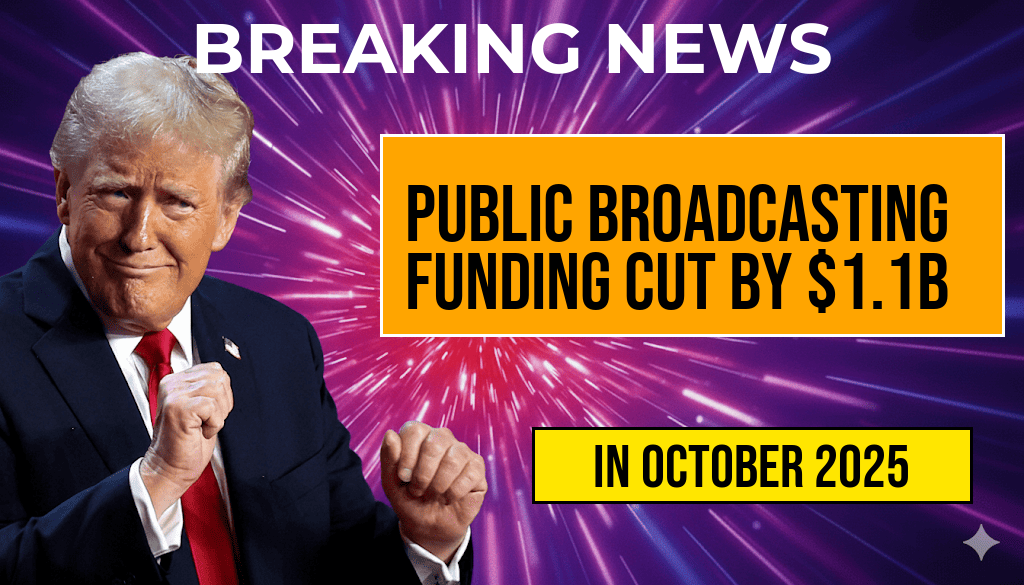The recently enacted Rescissions Act has resulted in a significant cut of $1.1 billion from federal funding allocated to public broadcasting initiatives across the United States. This reduction marks one of the largest single-year decreases in recent memory, raising concerns among public media advocates, educators, and policymakers alike. The funding decrease impacts key organizations such as the Corporation for Public Broadcasting (CPB), which serves as a primary conduit for federal dollars supporting PBS, NPR, and local stations. Officials warn that the loss could lead to diminished programming, reduced outreach efforts, and potential layoffs, threatening the sustainability of local stations and the diversity of content available to American viewers and listeners.
Details of the Funding Reduction
Scope and Breakdown of Cuts
| Funding Source | Previous Allocation (2023) | Rescinded Amount | Post-Rescission Funding |
|---|---|---|---|
| Corporation for Public Broadcasting (CPB) | $445 million | $200 million | $245 million |
| State and Local Grants | $300 million | $150 million | $150 million |
| Other Federal Support | $150 million | $50 million | $100 million |
The total rescission of $1.1 billion is spread across multiple programs, with the majority coming from the CPB’s core budget. The legislation, signed into law last week, specifies that these cuts are aimed at reducing federal expenditures but has sparked debate about the long-term effects on public media services.
Reactions from Public Media Leaders
Concerns Over Programming and Accessibility
Leaders within public broadcasting have expressed alarm over the potential consequences of the funding reduction. Patricia Harrison, President and CEO of the CPB, emphasized that the cuts threaten the very fabric of public media’s mission to serve underserved communities and provide educational content. “This level of rescission could force local stations to cut back on programming, reduce community outreach, and even consider layoffs,” Harrison stated in a recent press conference. She added that the channel’s ability to innovate and expand digital offerings might also be impaired.
Political and Policy Context
Supporters of the rescission argue that federal spending must be curbed amidst broader fiscal tightening efforts. Congressman John Doe (R-XYZ), a proponent of the measure, noted that the cuts align with a broader push to reduce government intervention and promote private sector solutions. “Public broadcasting has historically received significant federal support, but it is time for local and private entities to take on a larger role,” Doe said during congressional hearings.
Impact on Local Stations and Communities
Potential Service Reductions
- Decreased local programming and community engagement initiatives
- Fewer educational outreach programs for schools and underserved populations
- Possible layoffs of station staff and reduction in operational hours
Audience and Educational Implications
Public broadcasters serve a vital function in delivering educational content, especially in rural and low-income areas where commercial media often lack a presence. The funding cut threatens to diminish access to PBS’s extensive educational programming, including renowned series like “Sesame Street” and “Nova”. Educational advocates warn that students relying on these resources for supplemental learning could face setbacks, highlighting the importance of stable, federal support in bridging educational gaps.
Legal and Legislative Perspectives
Legislative Background
The Rescissions Act was passed as part of a broader effort to reduce federal deficits by rescinding unspent appropriations from previous fiscal years. The legislation was introduced by bipartisan sponsors and passed both chambers of Congress with bipartisan support, reflecting a consensus on budget austerity measures.
Legal Challenges and Future Outlook
Some legal experts question the constitutionality and procedural aspects of the rescission process, arguing that it may set a precedent for further reductions in federally funded programs. Advocacy groups are exploring legal options to contest parts of the law, emphasizing that public broadcasting is protected under the First Amendment as a vital component of free speech and an informed citizenry.
Broader Implications and Next Steps
Federal Funding Trends
The rescission signals a shifting landscape for public media, which has historically relied on a combination of federal, state, and private funding. The current reduction may accelerate efforts to diversify funding sources, including increased donations and corporate sponsorships.
Policy Discussions Ahead
As Congress debates future appropriations, public broadcasting advocates are urging lawmakers to restore or even increase funding levels, emphasizing the sector’s role in education, democracy, and cultural preservation. Stakeholders are also calling for reforms to ensure more sustainable, bipartisan support for public media in the years ahead.
For further information, see Public broadcasting in the United States and the NPR Annual Report.
Frequently Asked Questions
What is the main impact of the Rescissions Act on public broadcasting funding?
The Rescissions Act has resulted in a significant cut of one point one billion dollars from public broadcasting funding, potentially affecting programming, stations, and community services.
Why was the funding for public broadcasting cut by the Rescissions Act?
The rescission was part of broader budget adjustments aimed at reducing federal expenditures, prioritizing other areas of government spending, and addressing fiscal deficits.
How might these funding cuts affect public broadcasting stations and content?
The funding reductions could lead to decreased programming, staff layoffs, and limited community outreach, ultimately impacting the quality and availability of public broadcasting content.
Are there any provisions to restore or contest the funding cuts?
Currently, the Rescissions Act is enacted law, but stakeholders and lawmakers may advocate for restoration or contestation through future legislation or budget negotiations.
What are the potential long-term effects of this funding cut on public broadcasting?
The long-term effects may include reduced diversity of programming, diminished public access to educational content, and challenges in maintaining the operational sustainability of public broadcasting entities.







